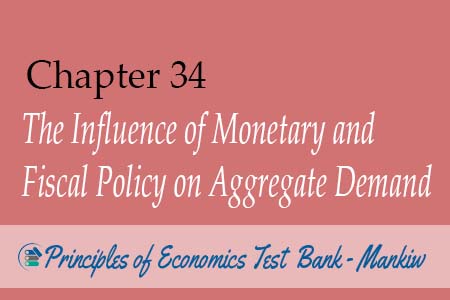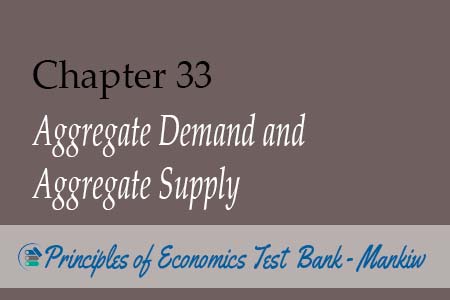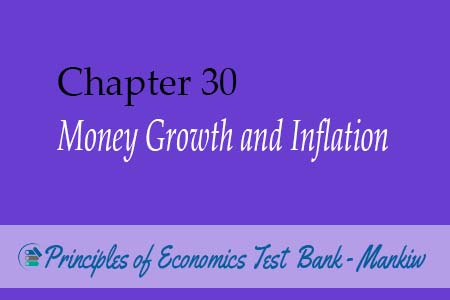 |
| Chapter 36: Five Debates over Macroeconomic Policy |
1. Stabilization
policy is useful because
a. there is no reason for society to suffer through the
booms and busts of the business cycle.
b. the economy would stabilize itself too quickly without
government intervention.
c. there are significant lags due to the nature of the
political process.
d. All of the above are correct.
2. The Federal
Reserve will tend to tighten monetary policy when
a. interest rates are rising too rapidly.
b. it thinks the unemployment rate is too high.
c. the growth rate of real GDP is quite sluggish.
d. it thinks inflation is too high today, or will become too
high in the future.
3. If the Federal
Reserve loosened monetary policy today because it believed a recession was
going to hit the economy in about one year, this is an indication that the Fed
a. is undertaking an inappropriate monetary policy.
b. recognizes the problem of lags.
c. recognizes the fact that money is neutral.
d. is conducting a procyclical monetary policy.
4. When economists
say that there is a time lag in the effect of monetary policy, they mean that
a. it takes time to observe the effects of fiscal policy on
the economy.
b. the Fed takes awhile to figure out what it wants to do.
c. the Congress takes awhile to figure out what it wants to
do.
d. it takes time to observe the effects of monetary policy
on the economy.
5. The outcome of
monetary policy can never be certain because
a. unemployment is always changing.
b. the concept of a natural rate of unemployment is still
not accepted by all policy actions.
c. the slope of the AS curve is never clear.
d. time lags disrupt policy planning.
6. Time inconsistency
occurs when what currently seems best for today and tomorrow
a. is not best for tomorrow.
b. is not best for today.
c. does not appear to be best when tomorrow comes.
d. cannot be determined.
7. In general,
economists who believe the Federal Reserve should stabilize aggregate demand
favor
a. policy rules that specify how the Fed should respond to
economic fluctuations.
b. a laissez-faire view of monetary policy.
c. discretionary monetary policy.
d. placing limits on the Federal Reserve’s open-market
operations.
8. One reason some
economists argue for a credible monetary policy rule is a belief that such a rule
could be used to
a. reduce inflationary expectations, and lower actual
inflation without raising the unemployment rate.
b. reduce inflationary expectations, and lower actual
inflation without raising the unemployment rate very much.
c. reduce inflationary expectations, and lower actual
inflation while the unemployment rate rises for only a short time period.
d. change the growth rate of real GDP without affecting the
unemployment rate.
9. If the Federal
Reserve followed a credible monetary policy rule, it would be better for the
economy than discretionary monetary policy because the Fed could use a rule
that creates low inflation; people would expect
a. low inflation, and the unemployment rate would be at its
natural level.
b. low inflation, and the unemployment rate could be kept
below the natural level.
c. even lower inflation, and the unemployment rate would be
kept below the natural level.
d. higher inflation, and the unemployment rate would be kept
below its natural level.
10. Proponents of
credible policy rules for monetary policy argue that credible rules are better
than discretionary policy because
a. only unanticipated policy actions affect real economic
variables.
b. over a period of time discretionary actions of the Fed
will become known, and then the Fed’s actions will no longer affect real
economic variables.
c. credible rules reduce uncertainty in the economy.
d. All of the above are correct.
11. The federal
government has run budget deficits every year since 1969. In recent years
Congress has voted on a constitutional amendment that would require a balanced
budget. If such an amendment were enacted it would
a. indicate that policy makers were taking a “business as
usual” attitude.
b. probably not change expectations.
c. increase the credibility of a deficit-reduction plan.
d. probably raise interest rates in the economy.
12. If the Federal
Reserve follows a policy of targeting the federal funds interest rate, then the
money supply will increase when
a. the unemployment rate falls.
b. when the rate of interest falls.
c. inflation decreases.
d. the demand for bank reserves increases.
13. One reason the
Fed tolerates ongoing inflation is because it
a. believes that the CPI understates the actual inflation
rate.
b. believes that the CPI overstates the actual inflation
rate.
c. accepts the idea that a zero inflation rate would make
labor markets work more smoothly.
d. wants to focus more on price stability than on full
employment.
14. Why doesn’t the
Fed eliminate inflation from the economy entirely?
a. It believes that the measured inflation rate understates
the true rate of inflation.
b. It recognizes that continuing inflation helps labor
markets adjust more easily.
c. If it did so, no one would get a raise in salary.
d. All of the above are correct.
15. What is the major
cost of slowing down ongoing inflation?
a. Output must rise above potential.
b. The Fed must sell bonds to the public at lower prices
than those at which the bonds were purchased.
c. Output must fall below potential.
d. The Fed must spend money on purchasing bonds from the
public.
16. Ongoing inflation
means the Fed must respond to
a. an upward-shifting AS curve.
b. a downward-shifting AS curve.
c. changing interest rate targets.
d. a lower real interest rate.
17. The national debt
a. can be paid off without major economic effects.
b. need never be paid off.
c. is no more serious a problem than is a corporation’s
debt.
d. should not exist during a period of economic prosperity.
18. The national debt
a. exists because of past government budget deficits.
b. is the difference between the government’s spending and
revenue in a given year.
c. is the amount households owe on credit cards, mortgages
and other loans.
d. is the same as the government’s budget deficit.
19. Government debt
and interest payments on that debt
a. are problems if they grow faster than GDP.
b. are unrelated in the short run.
c. are unrelated in the long run, but not in the short run.
d. generally grow faster than government spending.
20. In the long run,
large and continuing budget surpluses
a. mean higher taxes and a lower standard of living.
b. mean a larger money supply and higher interest rates.
c. are a problem because they crowd out private spending.
d. permit the government to lower taxes, thereby encouraging
work, investment and saving.
21. The substitution
effect of higher interest rates says that
a. smaller amounts of savings will generate the same amount
of interest income.
b. higher rates of return increase the value of savings.
c. higher taxes will increase savings.
d. higher taxes will decrease savings.
22. The income effect
of higher interest rates says that
a. smaller amounts of savings will generate the same amount
of interest income.
b. higher rates of return increase the value of savings.
c. higher taxes will increase savings.
d. higher taxes will decrease savings.
23. U.S. government
policy discourages savings by
a. taxing the income from capital.
b. reducing benefits for those who have accumulated wealth.
c. limiting interest payments that banks can make on savings
accounts.
d. Both a and b are correct.
24. As compared to
discretionary tax policy, a credible commitment to low taxes on capital would
tend to
a. cause people to expect higher taxes in the future, reduce
incentives to invest, and reduce tax revenues collected on capital.
b. allay people’s expectations of future tax increases,
increase incentives to invest, and reduce tax revenues collected on capital.
c. allay people’s expectations of future tax increases,
increase incentives to invest, and increase tax revenues collected on capital.
d. allay people’s expectations of future tax increases,
increase incentives to invest, and could either increase or decrease tax
revenues collected on capital.
25. According to
supply-side economists, lowering corporate income taxes
a. results in higher wages without creating higher levels of
labor productivity.
b. creates greater income equality.
c. checks the expansion of GDP and employment.
d. stimulates investment and spurs on economic growth.
Chapter 36: Five Debates over Macroeconomic Policy - Principles of Economics Mankiw
Pretty.Much
Thursday, November 24, 2016








